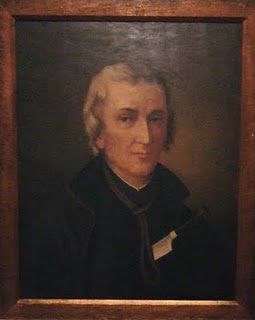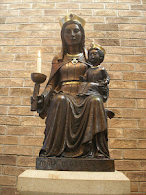 |
| ST STEPHEN & THREE WELSH MARTYRS DEPICTED IN A STAINED GLASS WINDOW IN THE CATHOLIC CHURCH, TENBY |
Today we celebrate the Feast of The Six Welsh
Martyrs of the Reformation. The Six
Welsh Martyrs, who were canonised by Pope Paul VI on 25th October
1970, are:
St Richard
Gwyn was born
about 1537 in Llanidloes, Montgomeryshire. He was a teacher and a married man.
He and his wife, Catherine, had six children. He was executed at Wrexham on
15th October 1584. St Richard Gwyn is the protomartyr of Wales.
St John Jones
O F M was born at
Clynog Fawr, Caernarvonshire around the year 1530. He entered the Franciscan
Convent at Greenwich and, at its dissolution in 1559, he went to the Continent
and was professed at Pontoise, France. He died for the Faith at Southwark on
12th July 1598. At his execution, he had to wait an hour because the hangman
had forgotten to bring the rope!
St John
Roberts O S B born at
Trawsfynydd, Merionethshire, was the first prior of St Gregory’s, Douai. He was
sent upon the English Mission in December 1602, arriving in England in April
1603. He was probably the first monastic to enter England since the
Reformation. He was executed at Tyburn on 10th December 1610.
St Philip Evans S J was born in
Monmouth in 1645. He entered the Society of Jesus on 7th September 1665. He was
ordained at Liege and sent upon the English Mission in 1675. He diligently and
joyfully served the area of South Wales for four years before his arrest at the
house of Christopher Turberville at Sker, Glamorganshire on 4th December 1678.
He was martyred at Cardiff on 22nd July 1679. He was thirty-four years old.
St John Lloyd was Brecon born and
studied at Ghent and Valladolid. He was ordained a priest at Valladolid in
1653. He returned to Wales and laboured in Brecon and Monmouthshire for 24
years. In November of 1678, he was captured at a house at Penllyn,
Glamorganshire. He and St Philip Evans shared a cell at Cardiff Castle until
their martyrdom at Cardiff on 22nd July 1679.
St David Lewis S J was born in 1616 at Abergavenny, Monmouthshire. He attended the local Grammar school where his father, Morgan Lewis, was headmaster. Ordained in 1642, David entered the Jesuit novitiate in 1645. He returned to Wales and, based at the Cwm, he served the Catholics of the area for 34 years. He was arrested at Llantarnam on 17th November 1678 and martyred at Usk on 27th August 1679. St David Lewis was the last Welsh martyr.
HYMN OF THE WELSH
REFORMATION MARTYRS
(Tune Hyfrydol or Blaenwern)
(Tune Hyfrydol or Blaenwern)
Came a time upon our nation
when the faith of Rome was banned.
Christians found their hearts were broken,
torn apart throughout our land.
Thus a traitor to the nation
anyone who loved the Pope.
Christians stood in condemnation.
Who could bring them any hope?
Men who trained
as priests for Cymru
came from Europe’s shores ere long.
Traversed far and wide our nation,
come to keep the Old Faith strong.
Saying Mass and heard confession,
priests of God , their only crime
was that laws of England’s kingdom
made such treason, at that time.
David Lewis, priest of Monmouth
gladly in Usk met his end.
As at Cardiff, Philip Evans
with John Lloyd, his holy friend.
From the north did Saint John Roberts
die for Christ, a Martyr true,
and Franciscan, Saint John Jones,
from the noose to heaven flew.
With these priests, to Rome so loyal,
one more Saint of Wales did die.
Richard Gwyn, the edict Royal
did at first its ways comply.
But this man, of Wales a teacher,
taught us now the better way.
He renounced the Royal churches,
chose with Rome alone to pray.
Time hath passed upon our nation,
the Old Faith no longer banned.
Other Christians, once oppressive,
now as friends beside us stand.
*This is
not a day for gloating,
Or for
raising ancient wrong,
but a day for celebrating
loyal Saints whose faith proved strong.*



.JPG)
.JPG)
.JPG)


.JPG)







.JPG)

.JPG)



.JPG)

